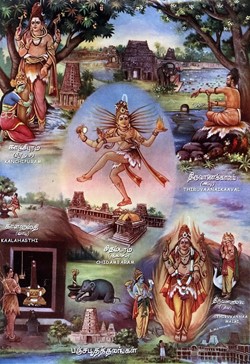 Pancha Bhoota Stalam or Pancha Bhoota Stala refers to the five Shiva temples, dedicated to Shiva, the most powerful Hindu god among the thirimurthis and also the most mercyful among them, each representing the manifestation of the five prime elements of nature- land, water, air, sky, fire. Pancha indicates Five, Bhoota means elements and Stala means place. All these temples are located in South India with four of these temples in Tamil Nadu and one in present-day Andhra Pradesh. The five elements are believed to be enshrined in the five lingams and each of the lingams representing Shiva in the temple have five distinct names based on the elements they represent.
Pancha Bhoota Stalam or Pancha Bhoota Stala refers to the five Shiva temples, dedicated to Shiva, the most powerful Hindu god among the thirimurthis and also the most mercyful among them, each representing the manifestation of the five prime elements of nature- land, water, air, sky, fire. Pancha indicates Five, Bhoota means elements and Stala means place. All these temples are located in South India with four of these temples in Tamil Nadu and one in present-day Andhra Pradesh. The five elements are believed to be enshrined in the five lingams and each of the lingams representing Shiva in the temple have five distinct names based on the elements they represent.
According to Hinduism, life and the various species originated by the combination of planetary globes and the five manifestations of nature namely air, water, fire, land and sky. Bhoota in Sanskrit means compound and maha bhoota indicates a big compound. According to Ayurveda, an ancient Indian medical system, the equilibrium of the body with the pancha bhoota is governed by the principles of tridoshas -kaph(phlegm), pitta(bile), vayu(gas), dhātu and malas(waste products). Rabindranath Tagore, a nobel lauerate for literature, in his poem, Pancha bhoota, has explained the emotional faculty of the human mind is keenly sensitive to all objects of light, colour, sound, effect of speed, sun, moon and stars.
The Five Temples
In Tiruvannamalai temple, Shiva is said to have manifested himself in the form of massive column of fire, whose crown and feet could not be found by the Hindu God of creation, Brahma and Hindu God of preservation (or maintainer) Vishnu. A celebration of this manifestation is seen even today in the age old traditions observed during the festivals of Sivarathri and Karthigai Deepam. Agni Lingam explains the mythics of life - duty, virtue, self-sacrifice and finally liberation by and through ascetic life -duty, virtue, self-sacrifice and finally liberation by and through ascetic life at the end of Agni kalpa. In Thiruvanaikaval temple, Shiva represents water element where the appu lingam is submerged in water and a perennial sub terrain spring gushes around the lingam. In Chidambaram, empty space is worshiped as Shiva (akasha lingam) to signify God is beyond human comprehension. It is unusual where there is no physical stone lingam present, unlike other temples of Shiva.
Thiruvarur is also considered to be the temple for Earth along with Kanchipuram.
The orders of the elements are in such a way because, Earth will be drowned in Water; Water will be absorbed by Fire; Fire will be put off by the Wind; and finally the wind will get dissolved in space.
- The lingam in Kanchipuram and Thiruvarur is made of Sand denoting Prithivi Sthalam.
- The lingam in Thiruvanaikovil is said to form of water worshipped by Goddess Parvati denoting Appu sthalam. Even today there is always water below the lingam in the sanctum sanctorum.
- The lingam in Thiruvannamalai is said to be in the form of fire, Where Lord Shiva stood up in the form of fire teach lesson to Brahma and Vishnu denoting Thejo sthalam.
- The lingam in Kalahasthi is said to have Air spaces to pass denoting Vayu sthalam.
- The lingam in Chidambaram is said have come from the cosmic space denoting Akasa sthalam.